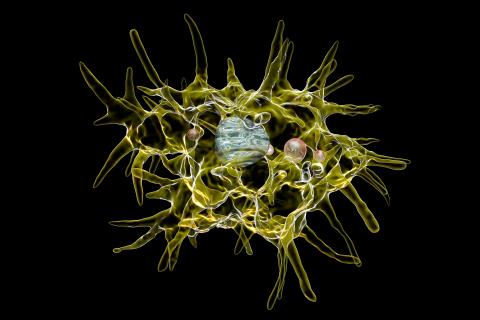Free-Living Amebae Infections
Free-living amebae (FLA) are microscopic, single-celled, living organisms found worldwide in water and soil.
There are certain types of FLA, including Acanthamoeba, Balamuthia, Sappinia, and Naegleria that can cause rare, but severe infections of the eye, skin, central nervous system (brain and spinal cord), or other parts of the body.
Most people will be exposed to these FLA during their lifetime, but very few will become sick.
FLA infections 101
There are four main types of FLA infections that can cause disease. The type of disease they cause can be different depending on what type of ameba is causing the infection and how it entered the body.
Acanthamoeba species (spp.)
Acanthamoeba is found worldwide in water and soil. Acanthamoeba species have been found in swimming pools; therapy pools; contact lens equipment; dental treatment units; dialysis machines; heating, ventilating, and air conditioning systems; and premise plumbing where biofilms protect them from disinfectants. The ameba can enter the body through cuts or skin wounds, by being breathed into the lungs, or by invading the eye after eye injury or using contact lenses.
Acanthamoeba are opportunistic FLA. In rare cases, they can cause a slowly progressing, mostly fatal disease of the brain and spinal cord called granulomatous amebic encephalitis (GAE), particularly in people with weakened immune systems. They can also cause a widespread infection that can affect the skin, sinuses, lungs, and other organs independently or in combination.
Acanthamoeba can also enter the eye in healthy people and cause vision-threatening Acanthamoeba keratitis (corneal infection), especially in people who wear contacts. Early recognition and treatment is important for preventing blindness.
Balamuthia mandrillaris
Balamuthia mandrillaris is a kind of ameba that has been found in dust and soil all over the world. It is also possible Balamuthia live in water. Balamuthia can enter the body when soil containing Balamuthia comes in contact with skin wounds and cuts, or when dust containing Balamuthia is breathed in or gets in the mouth. Once inside the body, this ameba can travel through the blood stream to the brain, where they cause GAE or widespread disease.
Sappinia pedata
Sappinia pedata has been implicated in a case of amebic encephalitis (brain infection) in an otherwise healthy person. There has only been a single reported case, and this person survived with treatment.
Naegleria fowleri
Naegleria fowleri causes an infection in people that quickly becomes a worse and usually deadly brain infection called primary amebic meningoencephalitis (PAM). It usually occurs in young, healthy people who spent time in warm untreated recreational water, like a lake. This ameba enters the body when water with the ameba is forced up the nose or enters the sinuses. Rarely, people have become infected after using contaminated tap water to rinse their sinuses. Treatment can help when the disease is found early. Read more on the DHS PAM webpage.
See a doctor if you suspect you have, or a family member has, an FLA infection. Special medications are available to help treat FLA infections.
Work with your doctor to decide on the best treatment for you.
To prevent Acanthamoeba keratitis, use good hygiene for contact lens care and use. See specific recommendations on the DHS Acanthamoeba keratitis webpage.
It can be hard to prevent other types of FLA infections because the ameba are present almost anywhere. Using safe water when rinsing your sinuses is important. Keeping water from going up the nose is the best way to prevent Naegleria fowleri infections.
Read more about how to prevent Naegleria fowleri infections on the DHS PAM webpage.
- Acanthamoeba Granulomatous Amebic Encephalitis; Keratitis: The CDC (Centers for Disease Control and Prevention) webpage that includes frequently asked questions, signs and symptoms, treatment and prevention information related to Acanthamoeba.
- Balamuthia mandrillaris, Granulomatous Amebic Encephalitis: The CDC webpage that includes frequently asked questions, signs and symptoms, treatment and prevention information related to Balamuthia mandrillaris.
- Healthy Contact Lens Wear and Care: The CDC webpage that covers best practices related to contact lenses.
- Sinus Rinsing for Health or Religious Practice: The CDC webpage that includes best practices for safely rinsing sinuses.
- PAM, Naegleria fowleri: The DHS webpage that includes information on signs and symptoms, prevention, and treatment.
Provider information
FLA infections are Category II reportable conditions in Wisconsin (except for PAM/Naegleria fowleri infection, which is Category I).
- Report to the patient's local public health department electronically, through the Wisconsin Electronic Disease Surveillance System (WEDSS), by mail or fax using an Acute and Communicable Disease case report, F-44151 (Word) or by other means within 72 hours upon recognition of a case.
- Information on communicable disease reporting
Wisconsin case reporting and public health follow-up guidelines
Case Reporting and Investigation Protocol (EpiNet):
- Information for Eye Care Providers and Public Health Professionals: The CDC webpage including scientific and clinical information about contact lens wear and care, as well as resources for promoting healthy habits among contact lens wearers.
- Acanthamoeba Information for Medical Professionals: The CDC webpage covering information on clinical features, diagnosis and detection, and treatment.
- Balamuthia Information for Medical Professionals: The CDC webpage covering information on clinical features, diagnosis and detection, and treatment.
- PAM/Naegleria fowleri webpage: The DHS webpage that includes information on signs and symptoms, prevention, and treatment.
- PAM/Naegleria fowleri for health care professionals: The CDC webpage that includes information on clinical features, diagnosis, and treatment.
Questions about free-living amebae infections? Contact us!
Phone: 608-267-9003 | Fax: 608-261-4976
Wisconsin Local Health Departments – Regional offices – Tribal agencies

